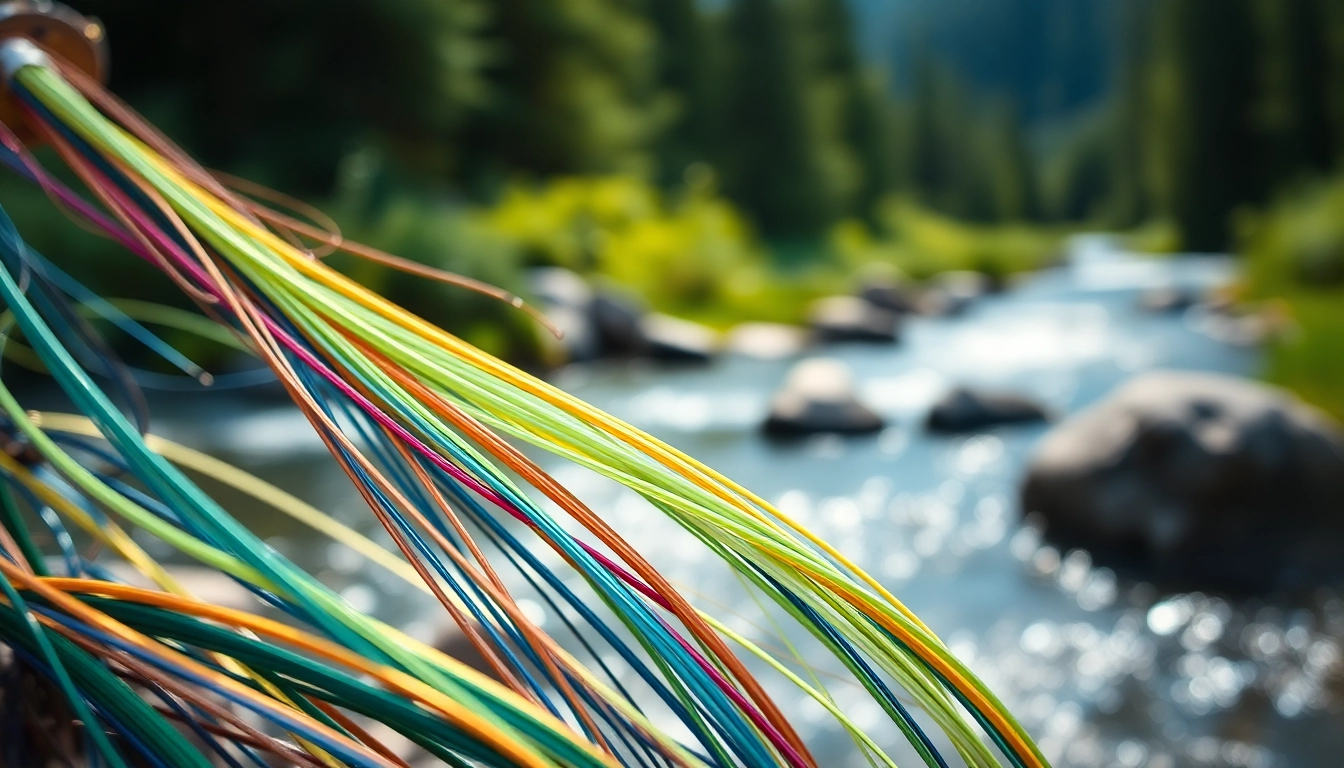Understanding Fly Fishing Lines
What is a Fly Fishing Line?
A Fly fishing line is an essential component of the fly fishing system. It is specifically designed to aid in casting flies, which are lightweight bait imitations used to entice fish. The fly line plays a crucial role as it is designed to carry the weight of the fly, ensuring that it reaches the desired distance while maintaining control. The fly line varies in thickness, weight, and material, allowing anglers to adapt based on the type of fish they are targeting and the fishing environment. The breadth of options available makes the selection of the right fly line pivotal for successful outings on the water.
Types of Fly Fishing Lines
Understanding the different types of fly fishing lines is crucial for anglers seeking to optimize their fishing experience. Here are the primary types:
- Weight Forward (WF): This type of line has a thicker front taper, which allows for longer and more accurate casts. It is commonly used for a variety of freshwater fishing scenarios.
- Double Taper (DT): This line is evenly tapered from both ends, providing the ability for delicate presentations with floating flies. It is especially favored in smaller streams.
- Shooting Head: This consists of a heavy line section for distance casting, often used with a separate running line. Ideal for experienced anglers targeting specific species in long casts.
- Sink Tip: These lines have a portion that sinks, enabling anglers to fish deeper waters while keeping the line buoyant overall. A versatile option for various water conditions.
- Full Sinking: Entirely submerged, this option is designed for fishing deep waters where surface flies are ineffective, making it beneficial in lakes and slow-moving rivers.
Key Features of Fly Fishing Lines
The effectiveness of a fly fishing line can be assessed through several key features:
- Weight: Lines are designated by weight classes, such as 2-weight, 5-weight, or 8-weight, determining their compatibility with specific rods and the types of fish targeted.
- Buoyancy: Lines come in floating, sinking, and intermediate types, allowing fishermen to choose based on the behavior of their target fish and water conditions.
- Tapper Design: The taper (shape of the line) influences the casting performance and presentation of the fly, with more aggressive tapers enhancing distance and delicate tapered lines improving accuracy.
- Material: Modern fly lines are made from various materials, including PVC and polyurethane, affecting the strength, durability, and waterproof capabilities of the line.
Factors to Consider When Selecting a Fly Fishing Line
Weight and Length Considerations
The selection of the appropriate weight and length of a fly fishing line is paramount for optimal performance. The line must be matched to the weight of the fly rod to ensure seamless compatibility. A conventional guideline is that the weight of the line should align with the designated weight of the rod. For example, a 5-weight rod should ideally use a 5-weight line. Additionally, the line length also matters; longer lines are typically beneficial for reaching greater distances, but can be challenging to manage in confined spaces.
Line Taper and Buoyancy Options
The taper design of the fly line can drastically alter the casting dynamics. Weight forward lines are exceptional for distance casting and can efficiently handle wind resistance, while double taper lines are splendid for short, delicate presentations. Buoyancy options—floating, sinking, and intermediate—must be selected based on fishing conditions. For instance, a floating line is versatile for top-water fly fishing, while sinking lines are better suited for deeper fishing locales or when targeting bottom-dwelling fish.
Environment-Specific Line Choices
Diverse environments necessitate different line specifications. In saltwater conditions, anglers require lines designed to withstand the corrosive effects of salt and heavy currents. Conversely, freshwater fly fishing might involve lighter lines that are more conducive to delicate presentations. Consideration of factors such as local fish species, availability of cover, and water currents will help determine the optimum line type.
Top Fly Fishing Line Brands to Explore
Evaluating Quality and Performance
When venturing into the world of fly fishing, the choice of line significantly impacts overall performance. Prioritize brands known for their reliability, durability, and innovation. Look for lines that have been tried and tested, often appearing in field reports from fellow anglers, reviews on fishing forums, or detailed product specifications from manufacturers. Quality indicators include construction materials, finishing treatments, and customer feedback on casting performance and longevity.
Comparative Pricing Analysis
Pricing varies considerably across lines, influenced by brand reputation, materials used, and special features. Entry-level lines might start as low as $20, whereas premium lines can exceed $100. It is crucial to strike a balance between cost and quality—investing in a superior line can vastly enhance your fishing experience, reduce replacement frequency, and improve satisfaction in casting accuracy. Conduct thorough pricing comparisons while considering user reviews for better insights on value proposition.
Where to Buy Reliable Fly Fishing Lines
Purchasing fly fishing lines can be done through various channels including local specialty fishing shops, online retailers, or large sporting goods stores. While in-person shopping provides the advantage of expert advice and immediate product experience, online shopping often offers a wider selection and customer reviews. Ensure that the retailer is reputable and that they offer a return policy in case the line does not meet your expectations.
Maintaining and Caring for Your Fly Fishing Line
Best Practices for Storage
Proper storage of fly lines is crucial to prolong their lifespan. Avoid storing lines under tension as it can lead to memory flaws. Instead, utilize line boxes or reels without strain. Additionally, keeping the lines clean and dry during storage prevents degradation from water, dirt, and other environmental factors. Consider investing in UV resistant storage solutions to protect from fading or damage caused by sunlight exposure.
Cleaning Methods to Prolong Longevity
Routine maintenance is essential to ensure optimal performance from your fly fishing line. Cleaning your line involves gently rinsing it with clean water and using a soft cloth to wipe away dirt, grime, and oils. For deeper cleaning, mild soap and water can be applied, but avoid harsh chemicals that may damage the line’s coating. Regular cleaning significantly enhances the fly line’s lifespan and performance in the water, contributing to better drag and overall casting success.
Repairing Minor Damages
Over time, fly lines may incur nicks, frays, or other damages. Invest in a quality line repair kit, which typically includes adhesives and patches specifically designed for fly lines. Small nicks can often be sealed with an adhesive, while larger damages may require replacing sections of the line. Familiarizing yourself with quick repair techniques allows anglers to continue fishing without significant downtime, ensuring that minor issues do not hinder the fishing experience.
Advanced Techniques with Fly Fishing Lines
Using Fly Lines in Different Weather Conditions
Weather plays a significant role in fly fishing, influencing fish behavior and angler strategy. In windy conditions, an appropriate weight forward line can help combat the elements, providing the necessary mass for casting. Conversely, during calm days, lighter lines can facilitate delicate presentations. Adjusting the type of flies used based on weather conditions can also be beneficial, with nymphs tending to be more effective in overcast conditions while dry flies may work wonderfully in steady sunny weather.
Optimizing Casting Techniques
Mastering casting techniques is an integral part of effective fly fishing. The double haul is a popular technique among advanced anglers that optimizes line speed and distance, allowing for more efficient casts. Practice and improve your timing and coordination to maximize the potential of your fly line. Regular practice on the water will refine your motions, enhancing not just accuracy but also your enjoyment of the sport.
Innovative Uses for Modern Fly Fishing Lines
Modern fly lines have evolved to integrate innovative designs aimed at enhancing performance. Some lines are built with advanced technology to improve sensitivity, casting distance, and accuracy. For instance, lines with built-in sink tips can save time by reducing the need for additional equipment when targeting fish at different depths. Embrace new designs and styles to adjust your approach to match various fishing conditions, ensuring continually optimized performance on every trip.



